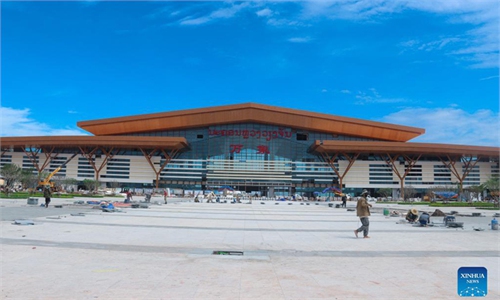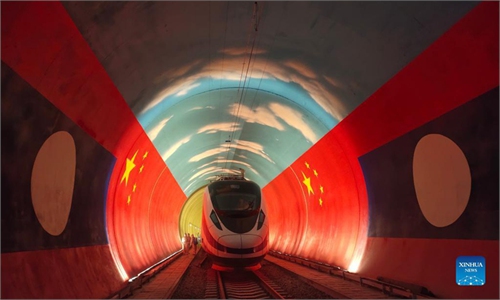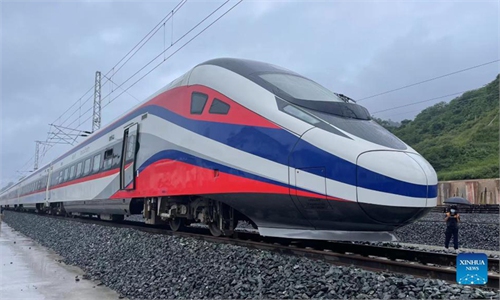Agricultural trade between China and Laos to double after rail link opens
Agricultural trade between China and Laos could potentially double

Photo taken on Feb. 5, 2021 shows the China-Laos Railway's Luang Prabang bridge across the Mekong River in northern Laos. Photo: Xinhua
The operation of the long-awaited China-Laos railway should be a significant boost not only to Laos' economy by enhancing its tourism and trade with China, but also to the economy of the entire Lancang-Mekong region, which includes Southeast Asian countries like Vietnam and Thailand, by securing an important transport junction in the region, experts said.
Top leaders from China and Laos will hold a video conference on Friday and jointly witness the official launch of the railway, Chinese Foreign Ministry spokesperson Hua Chunying said on Wednesday.
The 1,035-kilometer China-Laos railway, which started in December 2016, connects Kunming in Southwest China's Yunnan Province and the capital of Laos, Vientiane.
According to the Xinhua News Agency, the rail line, with a designated speed of 160 kilometers per hour, will greatly shorten the travel time from Vientiane to the China-Laos border from two days to just about three hours, while the journey to Kunming can be done overnight.
Experts said that the railway will serve as an important transportation junction for Laos, an inland country, and boost sectors of the Laotian economy like trade and tourism by facilitating the transport of goods and tourists between the two countries.
"In the past, goods were transported between China and Laos by road, which is only good for small quantities, or by air, which is relatively expensive. The China-Laos railway could greatly shorten the transportation time, which I think will definitely encourage trade between the two countries, particularly for farm goods, which have high requirements for freshness," Gu Xiaosong, dean of the ASEAN Research Institute of Hainan Tropical Ocean University, told the Global Times on Wednesday.
Gu said that China-Laos agricultural trade might double due to the railway's operation. Laos' entrepot trade might also increase as other countries will use it as a transfer station in transporting goods to and from China, he said.
China's exports to Laos increased by 12.7 percent on a yearly basis in US dollar terms in the first 10 months of this year, while imports surged by 42 percent, Chinese customs data showed. China mainly imports agricultural and mining products from Laos, while exporting raw materials and consumer goods, Gu said.
Besides stimulating China-Laos economic interaction, the railway could serve as an economic catalyst for the entire Lancang-Mekong region, which includes countries like Cambodia and Myanmar, by facilitating countries' trade and personnel interactions, experts said.
"Building a rail network that includes both China and the Lancang-Mekong countries, some of which are landlocked, is of vital importance to facilitate regional cooperation and economic development," Xu Liping, director of the Center for Southeast Asian Studies at the Chinese Academy of Social Sciences in Beijing said, giving the examples of faster shipments of Southeast Asia's fruits, Thailand's auto parts, and electronic parts.
It will largely benefit Thailand via existing rail line that runs through Laos, experts noted.
In September, the Thailand Rail Transport Department unveiled a plan to develop areas in Nong Khai to prepare for a rail connection with Laos. A section of the China-Laos rail line will be extended from the Laotian capital to the border with Thailand. Thailand expects to be connected with Laos and China in 2028, the Bangkok Post reported.
"Once Thailand is connected, it will lay a framework for building a trans-Asian network, as more countries like Malaysia and Singapore could be connected via the rail land route in the future," Xu told the Global Times on Wednesday.
He said that negotiations between China and Thailand have run into difficulties partly because the Thailand side has put the price too high. There are other options, such as extending the China-Laos railway further to Cambodia, a seaside country that has ports and shipping lines.
As for rail connections with other Lancang-Mekong countries like Myanmar and Vietnam, some were reportedly put on hold for various reasons including political concerns, observers say.
According to japantimes.co.jp, Vietnam has adopted Japan's bullet train system for a high-speed rail link, but there are also reports saying that Vietnam's high-speed electric railway line won't be completed before 2045.
Gu said there's a chance that Vietnam and China will pursue cooperation in building land transportation facilities, although the two countries have some friction in maritime issues.
"China-Vietnam relations are stable in general and the two countries have cooperation in a lot of aspects, particularly trade. I think the two countries need each other economically, and Vietnam should think positively about closer cooperation with China," Gu said.
According to Gu, although Vietnam has "complicated considerations" in terms of cooperation in building high-speed railways, the China-Laos railway should wake up Vietnam as convenience of fast transport will greatly aid Vietnam's economy.
"Because of the railway, China does not have to rely on Vietnam to interact with countries like Thailand and Malaysia, and Vietnam might be anxious about being 'marginalized'," he said.





